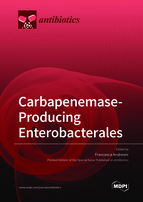Carbapenemase-Producing Enterobacterales
A special issue of Antibiotics (ISSN 2079-6382). This special issue belongs to the section "Mechanism and Evolution of Antibiotic Resistance".
Deadline for manuscript submissions: closed (31 December 2021) | Viewed by 59096
Special Issue Editor
Interests: antimicrobial resistance; carbapenemase; enterobacteriaceae; molecular typing; plasmid characterization; genetics; molecular biology; identification of vaccine candidates
Special Issue Information
The large family of Enterobacteriaceae includes such species as Klebsiella pneumoniae and Escherichia coli commonly responsible for healthcare infections. The increasing prevalence of resistance to antibiotics used to treat severe infections and diseases, in particular to carbapenems, is due to a rise in multidrug-resistant pathogens which pose an urgent threat to public health. Carbapenem-resistance is mainly associated with the production of carbapenemase—encoded by mobile genetic elements, which are usually plasmids that are horizontally acquired and highly transmissible. Carbapenem-resistant Enterobacteriaceae (CRE) are a common cause of infections in both community and healthcare settings. For this reason, the implementation of control measures and screening programs on CRE carriage is an important practical application toward limiting the dissemination of these strains between clinical wards. The focus of this Special Issue includes any aspects concerning plasmid-mediated antimicrobial resistance along with other carbapenem resistance mechanisms. Understanding the prevalence and routes of transmission of CRE is important in developing specific interventions for healthcare facilities. No less important is the general impact of CRE circulation on the environment. It is known that residues of antimicrobials that are widely used in clinical settings and also entering water and soil during intensive breeding create a selective pressure contributing to the increasing antibiotic resistance of microorganisms. In light of this, attention must be focused on carbapenemase testing in order to provide advanced phenotypic and molecular assays for the identification of CRE. Furthermore, the optimization of protocols could be a valid tool for active global surveillance, and from this perspective, the study of resistance mechanisms can provide significant support for the development of new and appropriate antimicrobial molecules. For all of these reasons, the phenomenon of carbapenem-resistance deserves more attention, for the sake of public health.
Dr. Francesca Andreoni
Guest Editor
Manuscript Submission Information
Manuscripts should be submitted online at www.mdpi.com by registering and logging in to this website. Once you are registered, click here to go to the submission form. Manuscripts can be submitted until the deadline. All submissions that pass pre-check are peer-reviewed. Accepted papers will be published continuously in the journal (as soon as accepted) and will be listed together on the special issue website. Research articles, review articles as well as short communications are invited. For planned papers, a title and short abstract (about 100 words) can be sent to the Editorial Office for announcement on this website.
Submitted manuscripts should not have been published previously, nor be under consideration for publication elsewhere (except conference proceedings papers). All manuscripts are thoroughly refereed through a single-blind peer-review process. A guide for authors and other relevant information for submission of manuscripts is available on the Instructions for Authors page. Antibiotics is an international peer-reviewed open access monthly journal published by MDPI.
Please visit the Instructions for Authors page before submitting a manuscript. The Article Processing Charge (APC) for publication in this open access journal is 2900 CHF (Swiss Francs). Submitted papers should be well formatted and use good English. Authors may use MDPI's English editing service prior to publication or during author revisions.
Keywords
- Carbapenem resistant Enterobacteriaceae
- Carbapenemase
- Active surveillance
- Infection control
- epidemilogy typing
- plasmid typing







